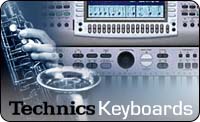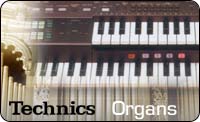



Home Page • About US • Events •Survey • Articles
Welcome To The Articles Page
Here at the Articles Page you can check out different articles from different years. Some articles will give you advice in helping you pick which Technic product you would like to purchase. Others would just incite you on what went on in the Technic world during those years.
1999
"Keyboards (France)"
- "Better than a workstation, the PR902 is more likely a playstation, actually an instrument created for the fun of playing music, with all the necessary options: Arranger, Sequencer, Processing, Floppy Disk, Composer System, Microphone Input with dedicated reverb and DSP's, Sound Edit& in brief, a dream piano for musicians."
"We have no other option than to be satisfied with the remarkable dynamic of the instrument. Velocity starts from zero, to reach magnificent amplitude, without any distortion, thanks to the amplifier quality&
"The Arranger is remarkably fluid on any type of chord and inversions, and we can say without any risk that the PR902 has a real feeling and that it really swings. Classical music fans will be satisfied with many subtle sounds and arrangements."
"Le Monde de la Musique"
March, 1999
- "For many years now, Technics has accustomed us to a very high level of quality in digital pianos manufacturing" "The very good action widely opens the door to a very diversified "palette" of digital nuances, allowing a very beautiful reproduction of legato. Phrasing possibilities are also extremely extensive thanks to the harmonic holding that the instrument proposes."
1998
"Keyboard Player" Magazine September 1998 "In-Depth Review Technics PR51"
Greg Palmer
- Anyone lucky enough to have been at the NAMM show in Los Angeles in January, the annual jamboree to which Stateside dealers, distributors and music fans flock to every year, will have got an early look at Technics' new digital ensemble, the PR51. Here in Britain and, indeed, in Europe, we've had to wait another six months to get a look at it.
Technics even kept it under wraps at Frankfurt in the spring preferring instead to save it for the official launch, alongside a new organ and keyboard at Castle Ashby, seat of the Marquess of Northampton, earlier in the summer. So now British dealers have got the PR51 in their showrooms.
But why all the secrecy, and has it been worth the wait? Well, it seems as if Technics has decided to stick by that old adage which says: "If is ain't broke, don't fix it." Anyone expecting surprises, or a radical departure from Technics' previous approach to these all -singing, all-dancing digital pianos is going to be disappointed. But I suspect the wise old heads at Technics headquarters in Japan will know that the majority of people interested in Technics digital ensembles will be more than happy that the magic formula has been tinkered with but left largely undisturbed.
What you get with the PR51 is more of the tried-and-trusted features which have stood Technics in good stead with the PR51's predecessors: quality core piano sounds, plenty of additional voices, stylish rhythm presets, easy-to-use sequencer and more.
The PR51 is being touted as a starter instrument, Technics' entry-level model, designed to provide a hassle-free way into the world of the one-man orchestra. So, one might expect a little dumbing down to be going on here and there, with corners being shaved to keep costs to a minimum for the manufacturer. But, I have to say, none of this was evident to me. In fact, the PR51 comes with a grand piano sound completely new to Technics' digital ensemble range; hardly evidence of the manufacturer palming-off the punter with second-hand goods.
Like previous PR range instruments the PR51 has four core piano sounds. Technics, like all the other major manufacturers, knows that, regardless of all the frills and thrills of the extras on these ensembles, it is the quality of these core sounds that will sell the instrument. Only after the punter is convinced about the tone of the acoustic pianos will the playability of the rest come into its own.
As regards the PR51 I found the Grand Piano extremely warm and welcoming, a feeling aided, no doubt by the overall friendliness of the instrument itself. It's a very up front kind of sound, just as you would expect from an instrument expected to make its presence felt in a room of some magnitude. It's bright and forthright, though not lacking in subtlety, too, when treated to a slightly less abrasive approach. I was surprised how much difference the soft pedal made to the sound. Of course, one would expect it to, but isn't always the case with digital pianos.
The Upright Piano sound is a kind of more polite tone, as comfortable as a favourite pair of slippers and just as equally at home in any living room. The Electric Piano is a kind of Rhodes/Wurlitzer hybrid, full of clunk and overtone. In a way it suffers because of this: it has neither the glassy charm of a Rhodes (except in the upper reaches) nor the seriously funky intention of the Wurlitzer. And the resulting sound offers nothing that grabs, to these ears at least. A classic case of something being less than the sum of its parts!
The last Piano patch is labelled Modern. Sadly, it isn't. Well, not anymore anyway. It's an imitation of Yamaha's DX7 electric piano, hardly cutting-edge. But it still has its place, I suppose. All four piano presets are strategically placed for easy right hand access, this positioning serving notice of the central importance of these piano sound to the PR51.
So, what about the rest of the instrument? Well, next on the checklist for me was the other preset sounds. Of course, the PR51 has the usual GM arrangement of sounds so that commercial MIDI files can be loaded-yes, the PR51 has a disk drive! - and read. Not surprisingly there are few surprises amongst the 181 additional sounds. I have to say, I do get slightly annoyed by banks of sounds with varying numbers of tones stored in them. I suppose it has to be because of the way that the GM standard has been set up. But it certainly goes against the way my brain works.







